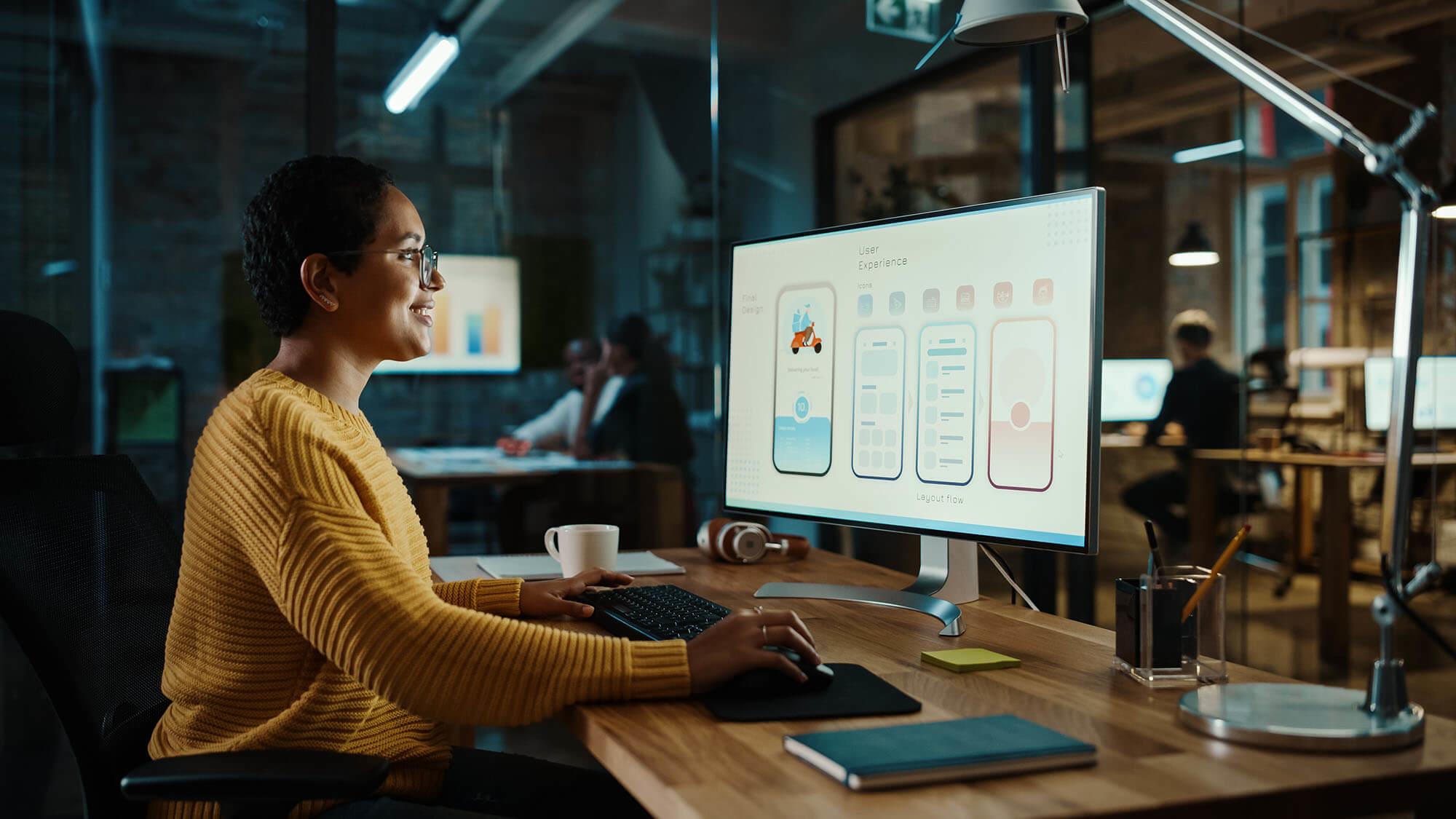Web Design London Ontario with Efficient Turnaround Delivery
Web Design London Ontario with Efficient Turnaround Delivery
Blog Article
Just How to Properly Integrate Aesthetic Appeals and Performance in Internet Design
When creating a website, you need to strike a balance between aesthetic appeals and functionality. It's not nearly looking great; your design must likewise offer a purpose and overview users effectively. By concentrating on simplicity and intuitive navigation, you can develop an interesting experience. However what aspects genuinely improve use while keeping visual charm? Let's explore the essential principles that can lead to a harmonious mix of elegance and feature.
Understanding the Value of Aesthetic Appeals and Performance
When you make an internet site, understanding the equilibrium in between aesthetics and capability is important for developing a reliable individual experience. An aesthetically enticing site grabs interest, but it's the capability that maintains users involved. If your website looks fantastic however is challenging to browse, visitors will rapidly weary and leave.Consider your target market and what attracts them in. You intend to create a style that reflects your brand while making sure ease of usage. Structured formats, intuitive navigation, and clear phone call to action can enhance both appearances and functionality.

Principles of Effective Website Design
To create an efficient website design, you require to abide by several crucial concepts that improve both individual experience and visual allure. Focus on simpleness; a clean design aids customers navigate conveniently. Make use of a constant color pattern and typography to keep comprehensibility across your site. This fosters experience and trust.Next, guarantee your design is receptive. Users gain access to internet sites on various tools, so your style ought to adapt flawlessly. Focus on aesthetic hierarchy; highlight essential elements with size, positioning, or color to direct customers' focus.Finally, integrate enough white area. It avoids mess and makes web content extra absorbable. Bear in mind, effective website design equilibriums aesthetic appeals and capability, so every layout choice ought to offer an objective. By adhering to these concepts, you'll develop a website that's not only aesthetically appealing but likewise straightforward, inevitably maintaining visitors involved and motivating them to return.
Prioritizing Individual Experience
When focusing on individual experience, you'll desire to start by recognizing what your customers truly require. Simplifying navigating style can make a big distinction in exactly how quickly they locate what they're trying to find. Additionally, improving aesthetic power structure helps guide their interest to one of the most essential aspects on your site.
Recognizing User Requirements
Recognizing customer demands is necessary for creating an interesting web experience that keeps site visitors coming back. To attain this, you should identify the objectives and preferences of your target audience. Beginning by performing user study, like studies or interviews, to gather insights on what customers value most. Focus on their discomfort points and obstacles when connecting with comparable internet sites. This details allows you to customize your layout, making sure capability aligns with user expectations. In addition, take into consideration developing user characters that represent different segments of your audience, assisting you visualize their needs throughout the design procedure. When you prioritize recognizing user needs, you develop a web site that not only looks terrific but likewise delivers a smooth, pleasurable experience that fosters commitment.
Streamlining Navigation Layout

Enhancing Aesthetic Power Structure
A strong visual hierarchy is important in leading customers with your web site and guaranteeing they engage with key material. To accomplish this, utilize shade, size, and spacing purposefully. Make essential components like headings bigger and bolder than body message, attracting interest right away. Use contrasting shades to highlight contact us to action, encouraging clicks. In addition, use ample white room to separate areas, making material digestible and inviting.Consider the flow of details; set up components logically, leading users' eyes from one point to the next. Use aesthetic hints, like lines or arrowheads, to direct attention. By focusing on visual pecking order, you boost individual experience and enhance the probability of conversions, guaranteeing your site is both aesthetically pleasing and functionally effective.
Color Concept and Its Effect On Usability
While picking the right shades for your web site may appear like a minor detail, it substantially influences functionality and user experience. Shade influences exactly how individuals view details and can impede or enhance navigation. For example, contrasting colors can assist essential aspects stand out, making click here it much easier for site visitors to locate what they need.Additionally, think about the psychology of shades: blue commonly influences depend on, while red creates urgency. Understanding your target market can direct your shade choices, assuring they resonate well.Moreover, consistent color design help build brand name identity, making your internet site more remarkable. Be cautious-- as well lots of colors can overwhelm users. Adhere to a minimal scheme that complements your material and keeps clarity.Incorporating ease of access is additionally essential; verify your color mixes get along for those with visual impairments. By attentively using shade concept, you'll boost usability and produce an extra appealing user experience.
Typography: Harmonizing Style and Readability
Shade options set the stage for your internet site, but typography plays an equally important function in boosting individual experience. You desire your message to communicate plainly while also showing your brand's personality. Begin by picking fonts that are not just eye-catching but additionally legible. Sans-serif fonts commonly work well for digital displays, as they're simpler to read at different sizes.Maintain a power structure by utilizing different font dimensions and weights; this overviews customers with your content effortlessly. Take into consideration line spacing and letter spacing; as well tight can discourage readers, while also loosened can interfere with the flow. Limitation your font style options to two or 3 to keep the style cohesive.Finally, always examine your typography throughout different devices and browsers. What looks excellent on one screen might out one more. Stabilizing design with readability guarantees that your message resonates, maintaining your audience engaged and notified.
Receptive Design: Making Looks Deal With All Gadgets
To ensure your website looks fantastic on any kind of gadget, you'll need to embrace receptive design concepts. This technique assurances your website adapts to numerous screen sizes, providing an excellent customer experience. Begin by using fluid grids and adaptable photos that scale flawlessly. As opposed to taken care of measurements, choose for percentages and family member devices, enabling your format to adjust dynamically.Next, implement media questions in your CSS. These let you apply various styles based on device features, like display width. This means, you can maintain aesthetic appeal while guaranteeing functionality.Don' t forget touch targets; make particular switches and web links are easy to tap on smaller displays. Prioritize vital web content, so individuals can easily navigate your website no matter of their gadget. By concentrating on these elements, you'll develop an engaging, visually appealing experience that meets the requirements of all users, whether they're on a tablet, smartphone, or desktop .
Performing Functionality Testing for Constant Improvement
To boost your website design, you require to set clear use objectives that align with individual demands. By performing customer tests, you can collect useful feedback on how real people interact with your website. Examining these results will aid you make informed improvements and produce an extra effective user experience.
Specifying Usability Goals
While looks can draw customers in, specifying usability objectives is necessary for ensuring their experience continues to be seamless and enjoyable. Begin by identifying what you desire individuals to attain on your website (website design london Ontario). Consider their behaviors, tasks, and demands. Are they seeking info, making an acquisition, or signing up for an e-newsletter? Develop clear benchmarks to gauge success, like job conclusion rates or time on task. Focus on intuitive navigating, easily accessible web content, and responsive layout to enhance functionality. Frequently revisit these objectives as individual expectations advance. By defining usability goals, you produce a structure for assessing and enhancing your site's efficiency. This concentrate on functionality not just enhances user satisfaction but likewise reinforces the general efficiency of your layout
Performing Individual Tests
Performing individual examinations is vital for fine-tuning your internet site and ensuring it fulfills your audience's needs. Start by identifying your target users and developing an examination plan that outlines your goals. Use a mix of qualitative and measurable methods, such as surveys, meetings, and task-based monitorings, to collect detailed feedback. Welcome individuals to browse your site while you observe their interactions and keep in mind any troubles they encounter. Urge open discussion to capture their thoughts and sensations about the layout and functionality. Keep sessions brief and focused, ensuring you cover essential locations without overwhelming customers. Ultimately, make certain to record all searchings for, as this information will certainly be invaluable for making enlightened design choices that boost both appearances and use.
Analyzing Test Results
Exactly how can you effectively assess the results of your use tests to drive constant enhancement? Start by classifying responses right into usual styles. Seek patterns in customer behavior that highlight discomfort points or areas for enhancement. Use quantitative information, like task conclusion prices and time on task, to gauge functionality fairly. Do not forget to take into consideration qualitative insights from individual remarks; they commonly disclose underlying concerns that numbers can't show. Prioritize one of the most impactful findings and produce actionable things for your style group. Remember, it's about iterating-- execute adjustments, then test once more. This cycle of testing, evaluating, and refining helps you balance visual appeals and performance, guaranteeing your website meets customer needs properly while keeping visual allure.
Often Asked Questions
Just how Do I Select the Right Shade Combination for My Site?
To choose the ideal color combination for your site, consider your brand name's character, target audience, and psychological effect (website design london Ontario). Use shade psychology, create consistency, and assurance readability. Test mixes to see what reverberates finest with site visitors
What Devices Can Assist With Website Design Aesthetics and Functionality?
You can utilize tools like Adobe XD, Figma, and Sketch to enhance your web style's aesthetics and performance. These systems supply user-friendly interfaces, partnership attributes, and pre-made templates to streamline your creative process and boost your styles.
How Can I Incorporate Animations Without Jeopardizing Performance?
To incorporate computer animations without jeopardizing capability, focus on subtle effects that enhance customer experience. Usage CSS computer animations for smoother interactions, warranty quick tons times, and examination on numerous tools to preserve performance while including visual allure.
What Prevail Errors to Prevent in Web Style Appearances?
When designing, stay clear of cluttered formats, bad shade options, and irregular font styles. Do not neglect mobile responsiveness, as it can estrange customers. Confirm your design straightens with your brand, developing a seamless experience that involves visitors efficiently.
Just how Commonly Should I Update My Website's Design for Optimum Looks?
You should update your site's layout every 1-2 years to stay up to date with patterns and preserve suitable looks. On a regular basis renewing visuals helps involve warranties and visitors your site remains enticing and straightforward. When you design a website, comprehending the balance between aesthetic appeals and capability is vital for producing an effective customer experience. To produce an effective web layout, you need to stick to several vital principles that enhance both customer experience and visual allure. Customers accessibility internet sites on numerous gadgets, so your style should adjust seamlessly. When prioritizing individual experience, you'll want to start by understanding what your customers truly need. Beginning by performing customer research study, like surveys or meetings, to collect insights on what users worth most.
Report this page